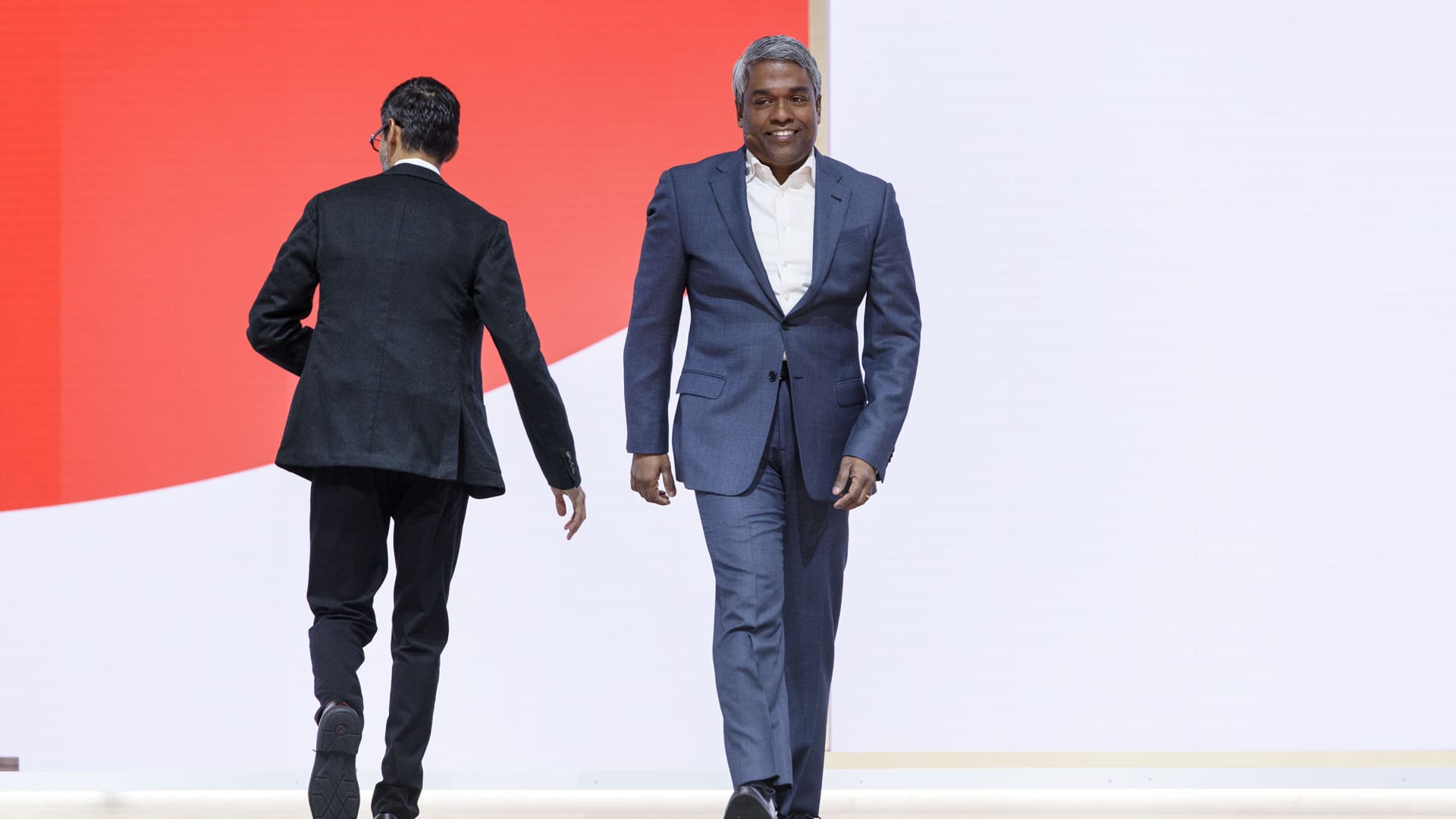Products You May Like
When Google hired Oracle’s Thomas Kurian four years ago to run its cloud business, the internet search company had a clear reason for putting its trust in a career enterprise software executive.
Google was a consumer company. Despite years spent trying to compete with Amazon and Microsoft in selling cloud-based storage, computing and other services to big corporations, it was coming up short in its effort to win marquee deals.
related investing news
While Google is still third in the U.S. cloud infrastructure market, its business is growing rapidly and, as of the first quarter, is finally contributing positively to Alphabet’s bottom line. Earlier this week, Alphabet said Google’s cloud unit generated $191 million in operating profit, after losing a total of $4 billion in 2021 and 2022. Revenue jumped 28% from a year earlier to $7.45 billion, far outpacing Google’s struggling ad business.
“We were not in a very good situation when I joined,” Kurian told CNBC in an interview after the results were released. “I think we were very early in the business. Most enterprises did not take us as a viable partner.”
The central problem wasn’t hard to spot. Google was a company of software developers and data scientists, who were trained at building sophisticated technologies. But they had no real idea how to build, market and sell them to the business world. Under Kurian’s predecessor, VMware co-founder Diane Greene, critics said Google’s cloud business hadn’t matured enough to handle enterprises even as it was investing heavily to do so.
The cloud division includes the Google Cloud Platform, which competes with Amazon Web Services and Microsoft Azure, and the Google Workspace productivity software bundle that goes head-to-head with Microsoft Office.
Kurian said he spent a lot of time with the technology in his early days to see how it worked and where it needed improvement. From 4 a.m. to 7 a.m., he would read technical design documents. In the evenings, he played with the products.
“We shifted the organization from thinking, we’re building technology to we’re building products and solutions,” Kurian said.
It’s a market Google has been committed to winning for years, as corporations have been rapidly pushing workloads from their own data centers to the cloud. Google wants to not only capture that storage and computing business but also get developers from those companies and others to use its cutting-edge technology, particularly as artificial intelligence systems gain traction.
The expansion has been costly. Almost every quarter, from the beginning of 2017 through the third period of 2020, finance chief Ruth Porat told analysts that cloud had been the biggest area of head count increases, for both sales and technical roles. Google also grew the operation through acquisitions, buying data analytics software startup Looker for $2.4 billion in 2019 and security software vendor Mandiant for $6.1 billion last year.
The cloud unit now accounts for more than 25% of Alphabet’s full-time workforce, CNBC reported earlier this year.
Kurian’s focus has included developing product road maps, introducing new pricing models, bolstering customer service and becoming more efficient with its infrastructure, a key to saving money.
“We’ve reduced cycle time in the way we provision and deploy machines by a factor of five in the last four years,” Kurian said. “There’s 100 different projects that have gone on to optimize resource consumption.”
Customer success is a practice that’s been widely adopted in the enterprise software world as a way to keep clients happy and wanting to buy more, emphasizing retention and limiting churn.
Google built up its customer-success mode to work more tightly with clients, and it racked up a community of 100,000 partners. The company has had hundreds of its senior engineers sponsor important customers so they could see how their products are being used and understand what needs to be changed.
“We have awards twice a year for teams that have done the best job helping customers,” Kurian said, adding that Google now ranks among the top five enterprise software sellers.
In 2020, Google brought its productivity tools under the brand Google Workspace. It also issued new pricing tiers, resulting in organizations of different sizes starting to pay different prices.
While Google’s cloud unit has swung to posting a profit, there’s some fuzziness in the numbers.
Last week, Alphabet restated operating income for cloud and its other segments, resulting in lower cloud losses in 2021 and 2022. The restated numbers show the cloud unit had a $186 million operating loss in the fourth quarter, compared with $480 million before the change, for example.
The cloud numbers also benefited from an extension of the useful life of data center equipment. But Kurian said competitors have made similar depreciation adjustments.
“We were always going to get to profitability,” he said. “If you draw the line, you can see the curve.”
‘Enterprise discipline’
Under Kurian’s leadership, Google’s cloud group has had to cope with its share of executive turnover. Javier Soltero, who was the head of Workspace, left in July. Rob Enslin, a former top SAP executive who joined Google as president of global customer operations in 2019, departed last year to become co-CEO of UiPath. And Kirsten Kliphouse, who was the cloud group’s president of Americas, left in 2023 after four years at the company.
But head count has continued to grow, as has the company’s roster of large customers. In the past three years, Google has signed deals with Coinbase, Deutsche Bank, Ford, General Mills and SpaceX.
And existing clients have gone deeper with Google.
Home Depot said it was adopting Google’s public cloud in 2016, while Greene was CEO. Fahim Siddiqui, Home Depot’s chief information officer, said the home-improvement retailer has found increasing value from Google’s platform since he joined from Staples in late 2018.
“He’s brought in the enterprise discipline,” Siddiqui said of Kurian. “It’s one thing to provide the capability of the cloud, a set of interesting technical capabilities. There’s a discipline of availability, reliability, management and being a proven partner on this journey.”
Siddiqui said Home Depot uses its own data centers and co-location facilities, as well as cloud services from Google and Microsoft. Google is the company’s main cloud-computing partner, he said, and last year Home Depot started moving merchandising applications to Google’s cloud.
A big partner move Kurian made in his early months as CEO involved what he called an “integrated open-source ecosystem.” It was an alliance with Elastic, MongoDB and five other companies that sell distributions of open source software.
Elastic and MongoDB shares rallied as Kurian, speaking at Google’s Next cloud conference, talked about how clients could receive a single bill while using products from other companies managed through Google’s cloud console.
“It was music to my ears,” said Dev Ittycheria, CEO of MongoDB, which sells cloud database software and services. At the time, AWS was attempting to add some open source MongoDB database software capabilities into its DocumentDB service.
Ittycheria said the open source initiative was Kurian’s idea, and he applauded how Google has arranged the partnerships. In 2021, Google said it was lowering the percentage of revenue it keeps in marketplace deals to 3% from 20%. Ittycheria said MongoDB is “very happy with the structure of the deal.”
Jeffrey Flaks, the CEO of Hartford HealthCare, which has 37,000 employees, said one reason why his Connecticut health system moved to Google Cloud Platform last year from its on-premises data centers is that other large hospitals had picked Google. He said Kurian was another factor in why it selected Google over AWS, Azure and Oracle’s cloud.
“His personal engagement, his knowledge of our intentions and our desires and, candidly, his personal problem-solving skills,” Flaks said, “distinguished Google Cloud in this process.”
Google Cloud technology chief Will Grannis said Kurian’s commitment to improving the division’s offerings was evident right away. Grannis recalled a day in late 2018, after Kurian had been picked for the role but before he’d actually started the job.
Kurian stopped by a Google office in Sunnyvale, California, and was introduced to employees. After the meeting, Grannis found himself alone in the elevator with Kurian and they rode down silently. As they walked toward the parking lot, Grannis, who was then a managing director, introduced himself, and they began talking about a container-management technology called Kubernetes.
“I’ve been trying to get some Kubernetes clusters spun up in the console, and I have some feedback,” Kurian said, according to Grannis. “I’d like to understand how we can improve the experience for developers.”
The conversation went on for an hour.




